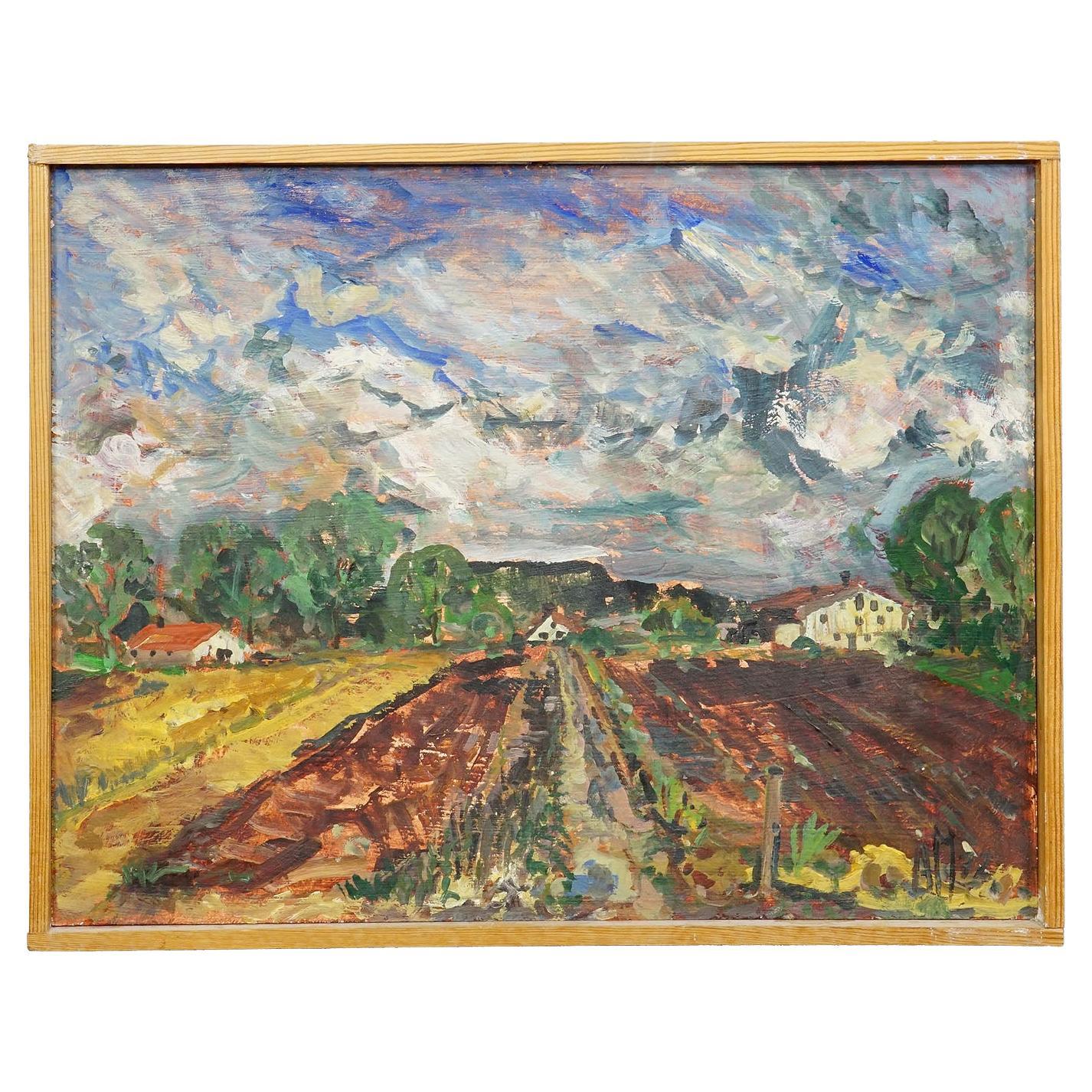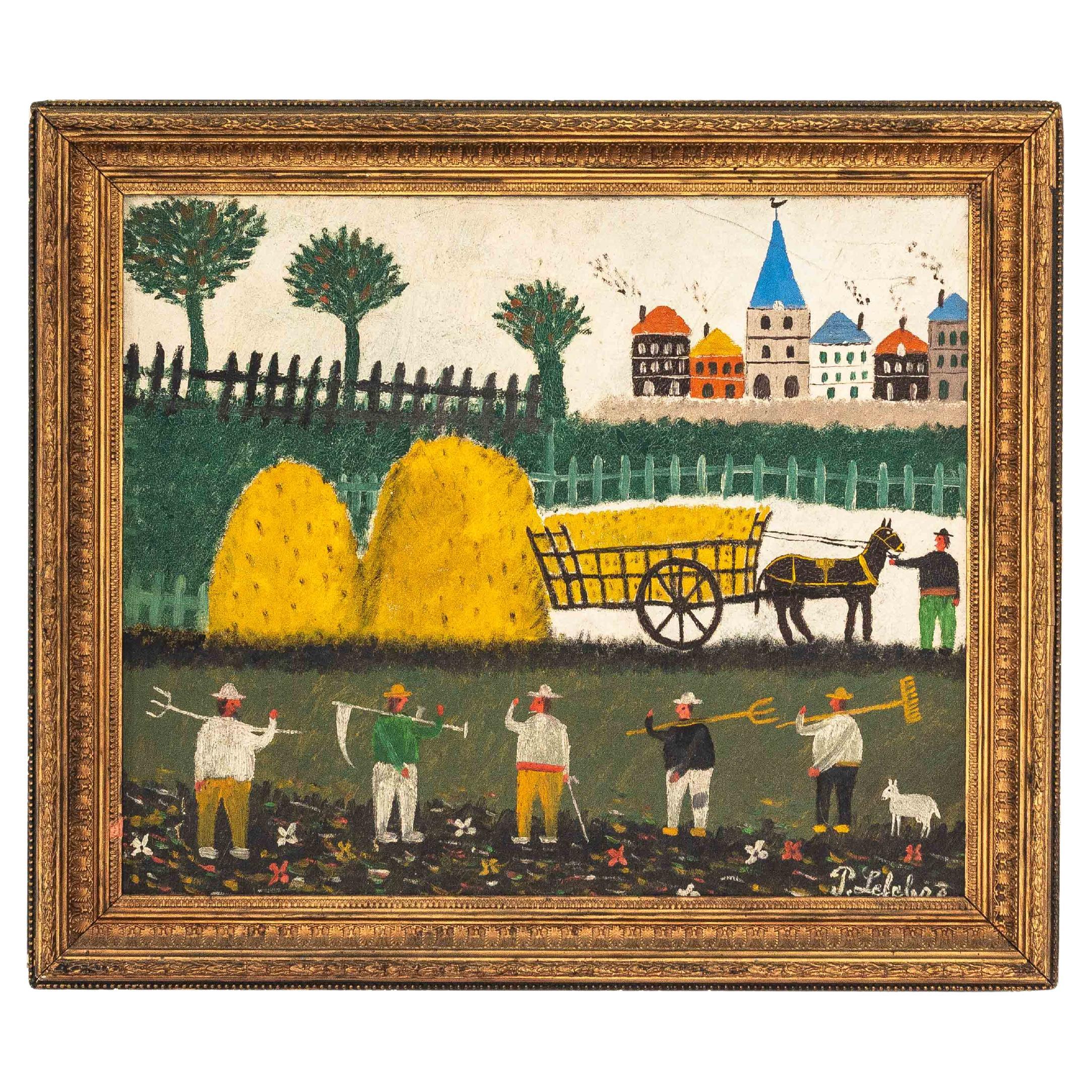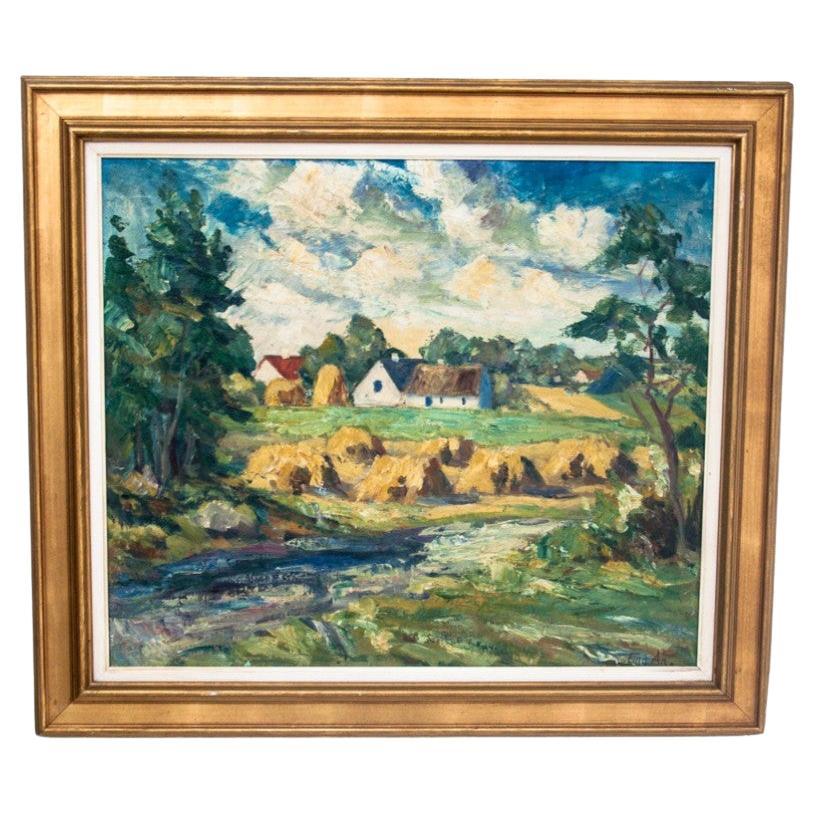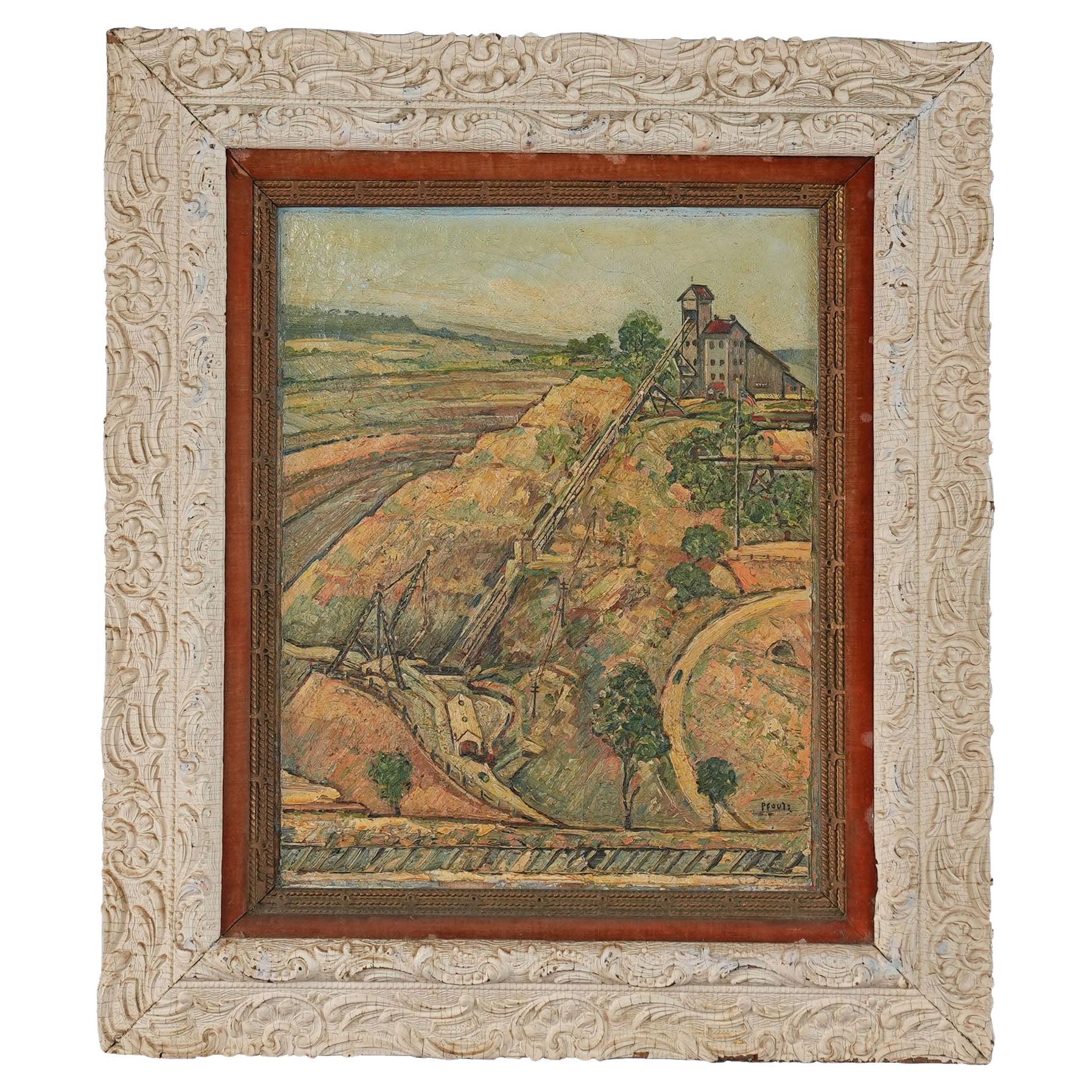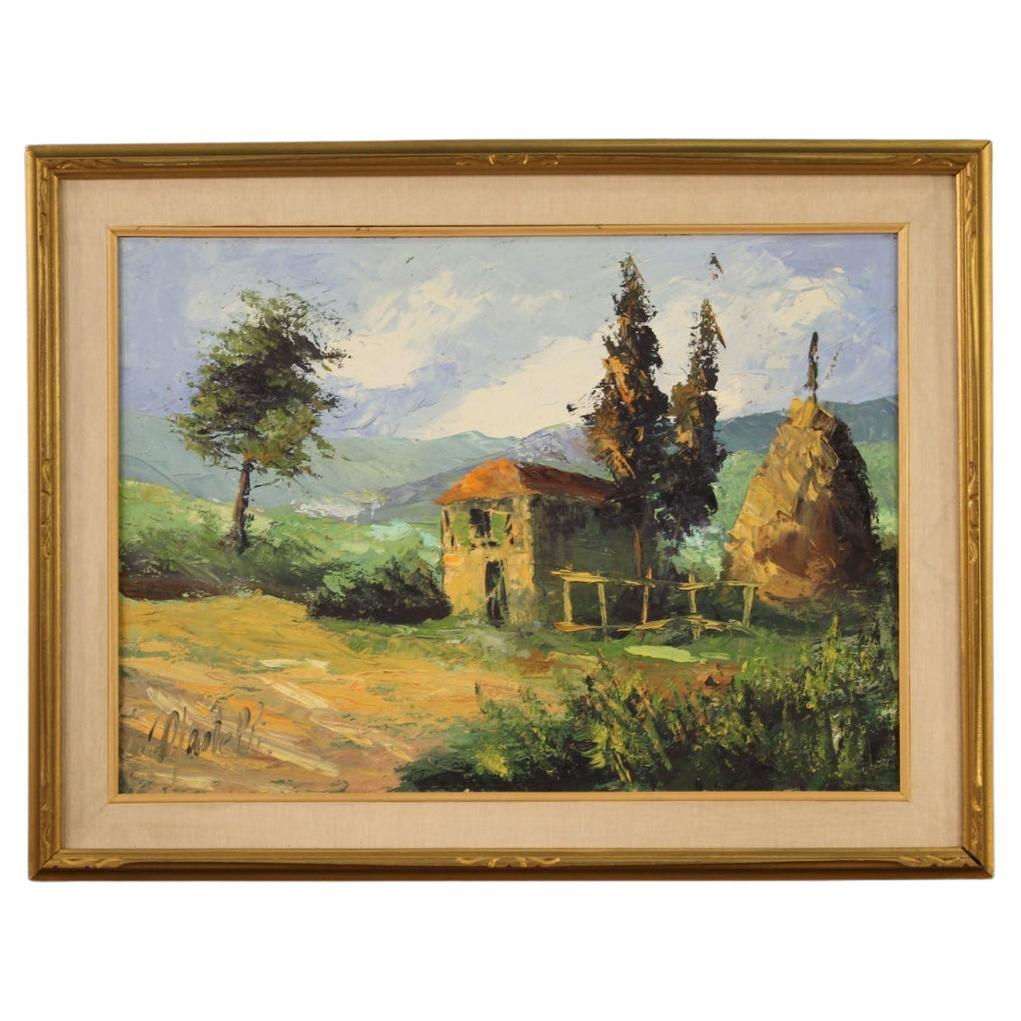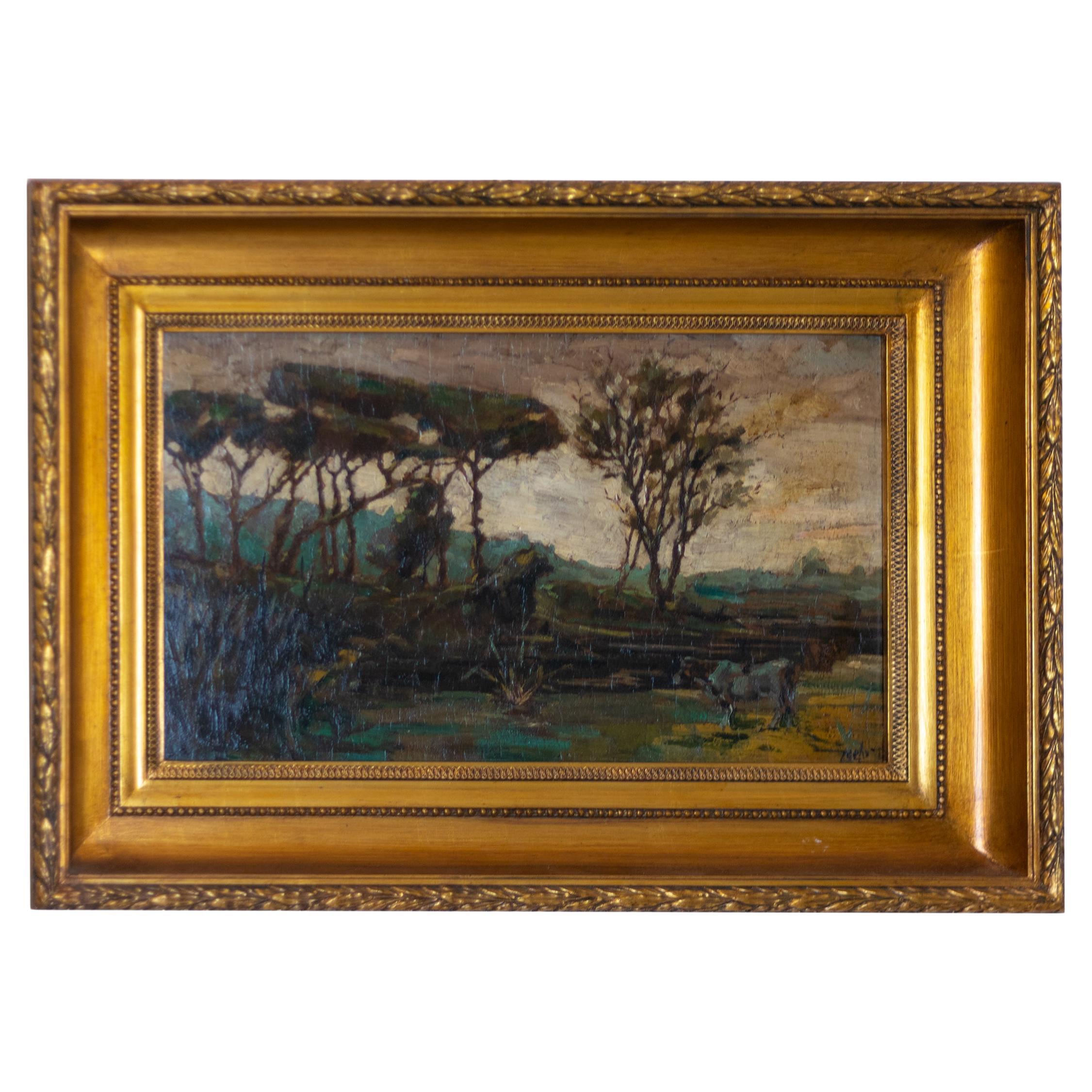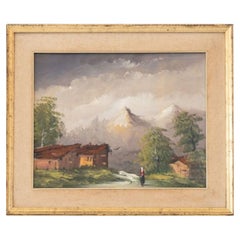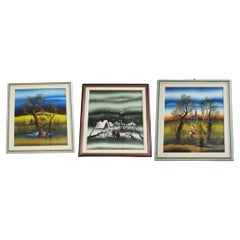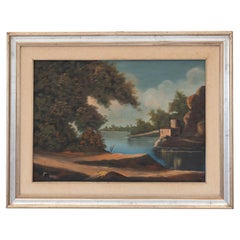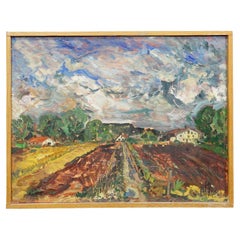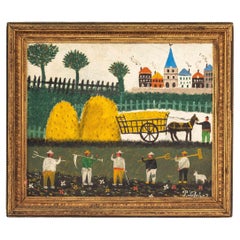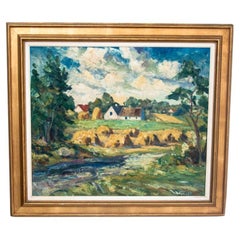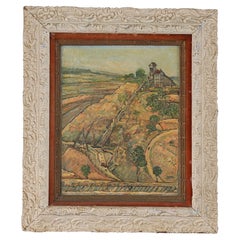Items Similar to Vibrant 1970 Painting of Agricultural Landscape by Zavagnor - A Celebration of R
Want more images or videos?
Request additional images or videos from the seller
1 of 10
Vibrant 1970 Painting of Agricultural Landscape by Zavagnor - A Celebration of R
$460.77
$708.8735% Off
£345.37
£531.3435% Off
€390
€60035% Off
CA$633.01
CA$973.8735% Off
A$706.70
A$1,087.2335% Off
CHF 370.30
CHF 569.6935% Off
MX$8,650.72
MX$13,308.8035% Off
NOK 4,702.83
NOK 7,235.1235% Off
SEK 4,434.17
SEK 6,821.8035% Off
DKK 2,968.82
DKK 4,567.4235% Off
Shipping
Retrieving quote...The 1stDibs Promise:
Authenticity Guarantee,
Money-Back Guarantee,
24-Hour Cancellation
About the Item
Vibrant 1970 Painting of Agricultural Landscape by Zavagnor - A Celebration of Rural Life
This captivating painting by Zavagnor from 1970 offers a vibrant and nostalgic glimpse into rural life. The artist skillfully captures the essence of an idyllic countryside scene, where the natural beauty of the landscape merges with the simplicity of agricultural life. The vivid colors and expressive details evoke a warm, inviting atmosphere, making this piece a standout addition to any art collection.
Key Features:
Artist: Zavagnor
Year: 1970
Style: Naïve art, with a focus on rural and pastoral scenes
Medium: Oil on canvas
Theme: A lively agricultural landscape featuring figures, animals, and a watermill, set against a striking sunset sky
Color Palette: Rich, warm tones with contrasts of red, yellow, and green, creating a dynamic visual experience
Condition: Well-preserved, with the original frame
Dimensions:
Frame Height: Approx. 23.62 inches (60 cm)
Frame Width: Approx. 31.50 inches (80 cm)
Depth: Approx. 1.18 inches (3 cm)
Why You'll Love It:
This painting is more than just a depiction of a rural scene; it's a window into a simpler, more peaceful world. Zavagnor's use of vibrant colors and detailed composition draws you in, making you feel a part of the tranquil landscape. It's perfect for those who appreciate folk art and want to bring a touch of rustic charm to their space.
Perfect for Various Interior Styles:
Whether you have a country-style home or a modern interior that needs a touch of warmth, this painting can be the perfect addition. It brings a pop of color and a sense of serenity to any room, from living areas to bedrooms or even an office.
Styling Tips:
Place this painting in a well-lit area where its vibrant colors can be fully appreciated. Consider pairing it with rustic wooden furniture or other folk art pieces to enhance its charm and authenticity.
About the Seller
5.0
Vetted Professional Seller
Every seller passes strict standards for authenticity and reliability
Established in 2017
1stDibs seller since 2023
23 sales on 1stDibs
Typical response time: 1 hour
- ShippingRetrieving quote...Shipping from: MANZANO, Italy
- Return Policy
Authenticity Guarantee
In the unlikely event there’s an issue with an item’s authenticity, contact us within 1 year for a full refund. DetailsMoney-Back Guarantee
If your item is not as described, is damaged in transit, or does not arrive, contact us within 7 days for a full refund. Details24-Hour Cancellation
You have a 24-hour grace period in which to reconsider your purchase, with no questions asked.Vetted Professional Sellers
Our world-class sellers must adhere to strict standards for service and quality, maintaining the integrity of our listings.Price-Match Guarantee
If you find that a seller listed the same item for a lower price elsewhere, we’ll match it.Trusted Global Delivery
Our best-in-class carrier network provides specialized shipping options worldwide, including custom delivery.More From This Seller
View All1960s Mountain Landscape Oil Painting - Tranquil Alpine Scenery
Located in Manzano, IT
1960s Mountain Landscape Oil Painting - Tranquil Alpine Scenery
Step into the serene beauty of the mountains with this exquisite oil painting from the 1960s. Capturing the tranquility and majesty of alpine scenery, this artwork reflects the timeless allure of nature. The artist's use of soft brushstrokes and a muted color palette creates a calming atmosphere, making this painting a perfect addition to any space that seeks to evoke peace and natural beauty.
Key Features:
Era: 1960s
Medium: Oil on canvas
Style: Realism, with a focus on natural landscapes
Subject: A peaceful mountain landscape...
Category
Vintage 1960s Italian Paintings
Materials
Canvas, Wood
$430 Sale Price
35% Off
1991 Mugosa Naïve Art Triptych - Original Oil on Canvas Paintings ( set of 3 )
Located in Manzano, IT
1991 Mugosa Naïve Art Triptych - Original Oil on Canvas Paintings set of 3
Discover the whimsical charm of naïve art with this captivating triptych by the artist Mugosa, painted in ...
Category
1990s Paintings
Materials
Canvas, Fir
$1,689 Sale Price
35% Off
1977 Landscape Oil Painting by Francis Torry - Timeless Natural Beauty
Located in Manzano, IT
1977 Landscape Oil Painting by Francis Torry - Timeless Natural Beauty
This captivating 1977 landscape oil painting by Francis Torry is a masterful representation of nature's serene...
Category
Vintage 1970s Italian Paintings
Materials
Canvas, Wood, Fir
$1,459 Sale Price
35% Off
Landscape with Windmill Printed on Gold Leaf - 1980s
Located in Manzano, IT
Landscape with Windmill Printed on Gold Leaf - 1984
This stunning print from 1984 features a serene landscape with a windmill, elegantly printed on gold leaf. The metallic background adds depth and warmth to the scene, creating a timeless piece that merges traditional landscape art...
Category
Vintage 1980s Italian Paintings
Materials
Gold Leaf
$345 Sale Price
35% Off
Stunning 1970s Gold Leaf Painting with Silver Frame
Located in Manzano, IT
Stunning 1970s Gold Leaf Painting with Silver Frame
Elevate your space with this exquisite 1970s painting, masterfully crafted using luxurious gold leaf techniques. The artwork feat...
Category
Vintage 1970s Italian Decorative Art
Materials
Gold Leaf
$343 Sale Price
35% Off
1994 Still Life Oil Painting by Serini - A Contemporary Masterpiece
Located in Manzano, IT
1994 Still Life Oil Painting by Serini - A Contemporary Masterpiece
Immerse yourself in the refined elegance of this 1994 still life oil painting by the renowned artist Serini. This...
Category
1990s Italian Paintings
Materials
Canvas, Glass, Beech
$499 Sale Price
35% Off
You May Also Like
Alexander Michael Oil Painting of a Rural Landscape, 1972
Located in Berghuelen, DE
Alexander Michael Oil Painting of a Rural Landscape, 1972
This expressive rural scene by German artist Alexander Michael, dated 1972, is a vibrant portrayal of farmland and countrys...
Category
Vintage 1970s German Other Paintings
Materials
Wood, Paint
Naïve Art Oil Painting, Countryside Landscape, Village and Farmers, France 1950s
By Paul Gauguin
Located in ROUEN, Normandie
Naïve Art Oil Painting, Countryside Landscape, Village and Farmers, France 1950s
Signed "P.LEFEBRE" at the bottom right corner.
This vibrant painting by French artist P. Lefebre is...
Category
Mid-20th Century French Mid-Century Modern Paintings
Materials
Gold Leaf
Painting "Rural landscape", Denmark, early XX century
Located in Chorzów, PL
Painting "Rural landscape".
Origin : Denmark, early XX century
Paintor : unknown
Dimensions:
Frame: height 71 cm / width 81 cm
Image: height 55 cm / width 64 cm
Category
Vintage 1930s Scandinavian Other Paintings
Materials
Canvas
$378 Sale Price
20% Off
Pfoutz Original Farm Scene Oil Painting
Located in Annville, PA
A very interesting and unusual Pfoutz Original Farm Scene Oil Painting by artist J. Earle Pfoutz. The painting is produced on artist and comes complete with what appears to be an original artist decorated/painted frame. The Pfoutz Original Farm Scene Oil Painting is signed on the front by the artist and appears to be dated 1948 on the rear. Known for his unusual subjects Pfoutz outdid himself with this effort, capturing the essence of a Lancaster County farm but with the startling twist of portraying a large turkey vulture in the foreground. Definitely unique.
Overall frame Size approximately 33″ wide x 3″ deep x 26″ high
J. Earle Pfoutz had a long and distinguished career as a self trained artist. More can be learned about him from reading this article produced by Gary Hawbaker at askART
Earle Pfoutz Born: 1891 – Lancaster, Pennsylvania
Died: 1957
Known for: Landscape, figure, still life painting
An image of J Earle Pfoutz
Biography from the Archives of askART
J. Earle Pfoutz (John Earle Pfoutz) – (Oct 23, 1891-Nov 9, 1957)
“A seventh generation descendant of a Swiss family which arrived in America early in the 17th Century, J. Earle Pfoutz was born in Lancaster, PA, son of John Bachman and Susan Allison Pfoutz. He painted houses for a living and pictures for a life.
A self-taught artist, described as a primitive, he was distinctive for his vivid imagination and bold color application. He painted hundreds of Lancaster County scenes. Pfoutz traveled through the hills near his home and along the Susquehanna River in search of scenes. He began painting with a brush when he was fourteen, but added a palette knife after suffering an eye injury. He completed eighth grade in the Lancaster Public Schools and there his formal education ended. However, the Department of Public Instruction of the State of Pennsylvania thought so highly of his work as an artist that officials certified him as an art instructor and he taught for a year in the York (PA) public schools. He also was an art instructor under the program for disabled veterans, sponsored by the Veterans Administration, when he gave private instruction to veterans in their homes.
In 1947, J. Earle Pfoutz finally earned national recognition as an artist. His painting, Opalescent October, was chosen by the Museum of Art of Dayton Ohio, to travel all over the country for a year with its Group Exhibition. Described as a “very colorful, calm scene, iridescent in color, sweeping in design,” the painting started on its journey around the country early in 1948. In an interview with the Sunday News (Lancaster, PA – Nov 2, 1947), Pfoutz stated that he didn’t know whether he was a “primitive” or an “impressionist.” No master taught him, no school channeled his style. “Sometimes I didn’t eat, but I always managed to paint,” he recalled. Many of his hundreds of canvases -most of them not sold, but given away to friends – found their way to other parts of the country. “I never remember the day when I did not love color,” Pfoutz said. “I was about 12 years old when I saw my first palette – a string of different colored paint paddles that graced the stores of that day. As a boy I had two great desires. One was to be able to eat all the strawberry jam I could, and the other to possess a string of those beautiful paint paddles. Well, I’ve got my fill of jelly, but I’ve never yet got my fill of beautiful colors.”
In 1950, Pfoutz’s one man show of paintings made front page headlines in the Lancaster Intelligencer Journal: “Most of the twenty oil paintings on exhibition are landscapes, although there are several interesting figure studies. Colors again, as in all Pfoutziana are rich and full-bodied, but for the most part not as startlingly as in some of the earlier work. Most of the paintings were done during the past year, and also reveal the painter’s characteristic heavy impasto technique, in which the rich swirls of paint carry their own message. Among the figures, The Banjo Picker, and The Magician, are the most provocative. Both are character studies; the first being of a tramp musician whose drab clothing is set-off by a luminous aqua blue background. Modern in feeling and treatment is The Magician, a clown-faced wizard whose spinning ball in the air suggests the fourth dimension – space. The use of the primary colors in this picture serves to emphasize the theme effectively.
A large colorful landscape, Opalescent October, depicting rolling hills against a late afternoon sky is new to Lancastrians, as it has just returned from Dayton, Ohio, where it hung in the Dayton Art Institute. Another landscape with soft dreamy colors is Fantasie D’Autumne, and one of the loveliest pictures in the show. Pennsylvania Dutch Country is another with eye appeal, and was one of the works which was hung in the Old Customs House in Philadelphia during Pennsylvania Week, and before that in a collection of Pfoutz work in the same place. In deep contrast to the sunny skies and brilliant foliage of many of the pictures, is the somewhat morbid Worry, in which the center of interest is a tremendous rat. This, the painter explains, was symbolic of 1948 in China, which was ‘The Year of The Rat’ in the Chinese calendar. Background material for the picture was furnished to Pfoutz by author Pearl Buck.
Other pictures include Autumn Prelude, Miners Village, painted at Cornwall, PA; Humid Day, Saint Peters Kierch, at Middletown, PA; Lady Pfoutz, inspired by the painter’s wife; Sun Flowers, Sentimental Journey, Gyne, Luzon Woman, Old Bridge, The Cow Path. Lemures, based on Roman mythology, and Ethiopian, painted from an ebony wood carving from Kenya Province, S. Africa.”
In 1953, Pfoutz was installed as President of the Lancaster County Art Association. A. Z. Kruse, New York City artist, writer and member of the faculty of the Brooklyn College and the Cartoonists and Illustrators School, Manhattan, was the guest speaker. In January of 1953, thirty-five Pfoutz oils were exhibited at the Old Custom House in Philadelphia, PA under the sponsorship of the Carl Schurz Memorial Foundation. Several Lancaster County landscapes and covered bridges were included as well as Katy, a Pennsylvania Dutch scene. Symbolic paintings included End of the Second Day, the artist’s visualization of the second coming of Christ, and Twilight, typifying the grief of mothers of all lands for sons lost in battle.
In June of 1953, a Pfoutz oil made history in Lancaster. From the Lancaster New Era: “For the first in local art history, a painting has been withdrawn from an exhibition because of objections from viewers and hostesses serving at the show. The painting, Jeune Fille, a standing nude done by Pfoutz, was one of the paintings in the annual spring exhibition of the Art Association and had become the center of the controversy. Pfoutz said he took the painting down… ‘graciously but reluctantly.’ ‘From an artistic standpoint, there is nothing offensive about the painting,’ Pfoutz said. ‘This community just wants its nudes with clothes on.’ “It is most brilliant in color, and because it is so brilliant I thought it would make a nice lively spot for the show. This is the first time I’ve had to take a picture off the walls. I substituted a seascape for it.’ Pfoutz said he felt the painting brought a lot of viewers to the show because it was so controversial. It had never been exhibited before. ‘If this had been shown in a metropolitan city,’ he commented, ‘people wouldn’t have given it a second glance. But the viewpoint here is more conservative, even though I don’t think moderns would have minded.’ He said he felt the painting was neither ‘objectionable nor pornographic,’ but had complied with the wishes of fellow members of the Art Association who telephoned him to relay the protests they had received. The art controversy was the first to arise here publicly since the showing of Amish Grandmother, an oil by William Gropper which was part of the Gimbel Pennsylvania exhibit at the Griest Building several years ago. — Numerous viewers of Amish Grandmother, [a painting showing an Amish woman holding a white goose], expressed themselves quite vocally, calling it an affront to the Plain Folk. But it stayed on exhibit throughout the length of the Gimbel show. Pfoutz expressed no rancor, implying that if Gropper could take it so could he.”
After his death, there were several shows of Pfoutz’ work organized by his son J. Earle, Jr. J. Earle, Jr. also saw to it that President Eisenhower would receive an oil called The Cow’s Path. The president first saw the painting in 1950 when, as president of Columbia University, he visited Lancaster to address a student assembly at Franklin and Marshall College. After his address was over, the then Gen. Eisenhower stopped at the Fackenthal Library on the campus to view an exhibition of Pfoutz’s paintings. The Cow’s Path intrigued him. For some time, as his aides fumed to get him back on his time schedule, Eisenhower and Pfoutz talked, as artist to artist. Prior to his death, Pfoutz requested that The Cow’s Path be given to the President if he wanted it. The painting was presented to Ike at the White House in November of 1959. Mrs. Eisenhower owned a Pfoutz painting titled, In the Manor.
Though house painting was his livelihood, he worked for Millersville State Teachers College (now a university) for a time during World War II, and called himself “the Chimney Sweep of MSTC.” During that period he knocked out a dizzying canvas in the surrealist style (he thought it was terrible) and got into the campus newspaper when one of the students spotted it.
Earle Pfoutz was not the humble, downtrodden artist, not the Douanier Rousseau type at all. As he developed his skill and style through the years, he also fashioned a resilient confidence in himself as an artist. Whether he was building his own home (he built two) or painting one for somebody else, he never lost faith in his ultimate recognition—though he was never sure he would live to see it.
Whether he was working as a rigger for a hoisting company, in the Stehli Silk Mill of Lancaster, carving Cloister-style chairs, decorating old chests, cementing bricks from the old Safe...
Category
Vintage 1940s American Paintings
Materials
Paint
20th Century Oil on Canvas Italian Signed Landscape Painting Countryside, 1970
Located in Vicoforte, Piedmont
Italian painting from the second half of the 20th century. Artwork oil on canvas depicting landscape, countryside view in impressionist style of good pictorial quality. Painting of g...
Category
Vintage 1970s Italian Paintings
Materials
Canvas
Mello Junior's Landscape Cow Near River Painting, Portuguese School, 20th C.
Located in Lisbon, PT
A bucolic 20th century oil on wood painting of a cow by the river marked "Mello" by the portuguese painter Agostinho Mello Júnior Mello Jr, Portugal.
Dimensions:
Frame 68.5 x 48.5 c...
Category
20th Century Portuguese Paintings
Materials
Wood
$3,634 Sale Price
20% Off
More Ways To Browse
Spanish Style Chest Of Drawers
Tall Painted Swedish Cabinet
Victorian Monkey
Wood Carved Single Bed
Wood Netsuke
Wrought Iron Bed Used
Wrought Iron Lounge Chairs Vintage
18th Century Dutch Walnut Cabinets
19th Century French Wallpaper
70s Patchwork
Antique Chinese Games
Antique Corner Cabinet Cherry
Antique English Cup And Saucer
Antique Engraving Machine
Antique Hobnail
Antique Horse Brush
Antique Round Metal Wall Art
Antique Shirt Collars
